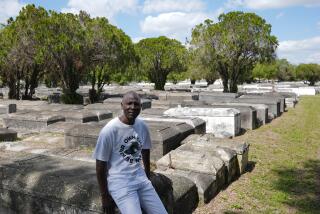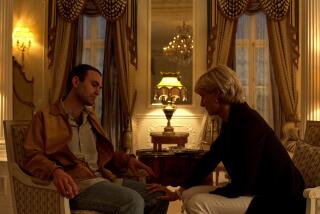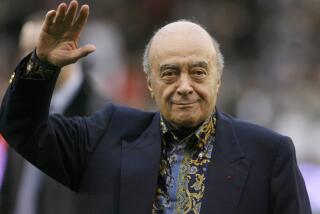It’s D-Day for Village Near Diana’s Grave
- Share via
GREAT BRINGTON, England — An observer might easily make the mistake of thinking that the childhood home of Princess Diana is the perfect setting for rural happiness.
The grand Althorp House rises out of a landscape of soft green fields. Nearby is the village of Great Brington, an idyllic composite of mossy walls, a church spire, cottages of golden sandstone and gardens filled with rosebuds and birdsong.
But there is no happiness this summer for the people of Great Brington.
For all of July and August, Diana’s brother, Charles Spencer, will throw Althorp open to any visitor prepared to pay $15 for a half-day tour of the estate where the princess is buried. Almost all of the 150,000 tickets have been sold for the lucrative two-month festival of grief designed by Spencer to mark the anniversary of her death Aug. 31 in a Paris car crash.
A foretaste of the Diana season came over the weekend at Althorp, with an open-air concert in the rain. Fifteen thousand damp, shivering fans turned out to hear a cast of Diana’s favorite stars, including pop veteran Cliff Richard, singer Chris de Burgh and cellist Julian Lloyd Webber.
“I know she is with us here in spirit,” an emotional De Burgh told the audience. But some of the listeners were less than delighted by the high prices Diana’s brother was charging.
“I’ve spent 62 pounds [$100] traveling here, a fortune on bed and breakfast, and now I find I have to pay 7 pounds [$12] for a program and stand around in the rain waiting to get in,” complained one visitor, Mary-Jane Hogg.
Although the open house is meant to raise money for charity, Spencer--a flamboyant character whose own marital infidelities, wife’s bulimia, divorce, quarrels with the “intrusive” media and spats with the British royal family have all been much reported in Britain--has been criticized for cashing in greedily on Diana’s memory.
“The dreadful Spencer family is inflicting yet more trouble on local people, and of course no one’s very happy about that,” said a villager who asked not to be named.
And local resentments over the plans to open Althorp are matched by national-level feuds between different groups trying to commemorate Diana.
Here, as in many other parts of Britain, a backlash has begun against the worldwide mourning, with oceans of cellophane-wrapped flowers, that followed the death of the blond princess who had been married to Prince Charles for more than a decade until their separation in 1995.
Some Britons are embarrassed and bewildered by what they believe was a cloyingly sentimental initial reaction to her death. And the much-publicized quarrels between organizers of the many rival charitable funds and shrines set up to remember Diana have soured public opinion still further.
Now, tight-lipped locals are waiting in dread for their peace to be destroyed by hordes of weeping visitors. They fear that the latest of many plans to raise money for charity from Diana’s death will inevitably create havoc as the unwanted guests stream through their village of a few hundred people.
“Of course, people are rather dreading the onslaught,” said London lawyer Michael Fowler, who grew up nearby and whose mother lives in the village. “My mother’s gone to Spain for the summer to escape the whole thing, the litter, the [buses], the postcards and the flowers. The endless, endless flowers.”
So, although the traditional deference of English country folk for their lords still prevents villagers from complaining loudly, they are quietly doing all they can to subvert Charles Spencer’s summer plans.
Locals with bitter memories of the crowds of tourists who flocked to Althorp to pay their respects immediately after Diana’s death have no plans to make this summer’s expected 2,500 visitors daily welcome. There is no tea shop in Great Brington, and its lone pub is shut all afternoon.
“There will be no teas and no toilets for them,” intoned Christine Whiley, who runs Great Brington’s one shop, a post office and confectionery store. She has, however, stocked up on postcards of Diana at 80 cents each and a memorabilia selection of books, face creams, prints and soft-focus photos, the last a hefty $25 each.
Pretty St. Mary’s Church--where Diana’s father, John Spencer, and generations of ancestors are buried behind wrought iron in the private Spencer chapel--is now festooned with discouraging signs reading “No Food, Animals, Or Flowers” and “Please Do Not Bring Flowers Into The Church.”
A gate is being built to block the direct road between manor and village. Although this will make life more inconvenient for the villagers, they believe it will be worth it if it prevents newcomers from finding their way into Great Brington to park. Police are politely turning away any buses they spot.
On a national level, there have been upheavals in the official Diana, Princess of Wales, Memorial Fund, which is administered by several trustees, including Diana’s sister, Sarah McCorquodale. The fund has raised nearly $80 million for half a dozen of the charities that Diana sponsored during her lifetime.
But it has been hit by scandal several times in recent months, notably over the disclosure that it let Diana’s signature appear on tubs of margarine.
Last month, spokeswoman Vivienne Parry resigned from the board of trustees after apologizing for some of its more visible mistakes, including the much-publicized margarine tubs.
More controversy has come from Mohammed Fayed, the owner of Harrods department store in London. His son, Dodi, Diana’s boyfriend, was killed with her in the crash. Fayed, whose application for British citizenship has been turned down repeatedly and whose relationship with the royal family is uneasy, has since aired public suspicions that Diana and Dodi’s deaths were part of an elaborate plot by the British establishment.
This hostility has been echoed in Fayed’s separate anniversary memorial plans. London’s Evening Standard newspaper reported in early June that Fayed plans to erect a 10-foot-high memorial to Diana and Dodi outside Harrods. Fayed quickly riposted that the report was “wrong, and merely part of a continuing media campaign to try to discredit Mr. Fayed.”
Since last summer, thousands of mourners have left money in a marble donation box at Harrods. It stands between photographs of Diana and Dodi, and profits are to be used by the Dodi Fayed International Charitable Foundation that Fayed set up in honor of his son.
But several newspapers reported last month that the foundation had not yet published accounts with Britain’s official Charity Commission. They should have been lodged as soon as $1,400 was collected.
A spokesman for the Charity Commission said: “Concerns have been raised with us, and we will be in contact with the people running the foundation.”
Fayed has in his turn been sharply critical of the official memorial fund, saying, “I don’t know what they do with their money except put on show-biz events, concerts and license margarine.”
Among the official fund’s most outspoken critics has been Charles Spencer, who has blasted its “tacky” merchandising deals. Paradoxically, he has also applied to register the trademark “Althorp” for use on soap, perfume, body lotion and imitation jewelry at his estate shop over the summer.
But any profits will go to the official memorial fund, his spokesman said. Nonetheless, there is grumbling. The price Spencer will charge to see Althorp makes it the costliest destination on Britain’s stately home circuit, more expensive even than Buckingham Palace, where admission is $11.
Spencer has also signed a deal with Penguin for his first book, a history of the Althorp estate and the Spencer family, to be published later this year. None of the profits from that project have yet been earmarked for the memorial fund, the Sunday Times reported.
But Spencer’s picturesque decoration of the burial place of his sister is sure to appeal to her many thousands of grieving admirers. Diana is buried on a small island on the grounds of Althorp.
“Her grave is unmarked, the exact spot known only to her close family. But in place of a gravestone, hundreds of tiny wildflowers and roses have been planted across the island. In the next few weeks, dozens of water lilies will rise to the lake’s surface and blossom,” the Mirror newspaper reported.
Perhaps it is the mythic quality of Diana’s hearts-and-flowers final resting place that has aroused the skepticism of down-to-earth locals; perhaps it’s just the hush-hush feel of the current preparations that is feeding a rural hunger for gossip and excitement.
Either way, at the Great Brington post office, Myra, the mother of an artist from the local town of Northampton, was eager to whisper a conspiracy theory.
“The night they brought her body back, after the big funeral ceremony in London, the whole village was invaded by the army and the police and the SAS [special forces]. All the villagers say they were hustled back into their houses to get them out of the way,” Myra muttered, dropping her voice melodramatically.
“Anyone around here will tell you that they got the crematorium in town burning late into the night. What we Northamptonians think is that they cremated her and scattered her ashes in the chapel, with her father and her family, and that this lady-in-the-lake business is just a way to make money from the tourists,” added Myra, who did not give her last name.
“And what we’d really like to know now,” she said, “is whether any of the money they’re going to earn from it is going to be spent locally, on us.”
More to Read
Sign up for The Wild
We’ll help you find the best places to hike, bike and run, as well as the perfect silent spots for meditation and yoga.
You may occasionally receive promotional content from the Los Angeles Times.






